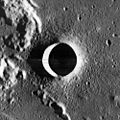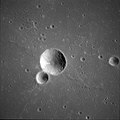
Beaumont is a lava-flooded crater located on the southwestern shore of the Mare Nectaris on Earth's Moon. It lies to the northwest of the similarly flooded crater remnant Fracastorius. To the west is the prominent crater Catharina. The crater is named after French geologist Léonce Élie de Beaumont.

Messier is a relatively young lunar impact crater located on the Mare Fecunditatis. The crater has a discernible oblong shape that is not caused by foreshortening. The longer dimension is oriented in an east–west direction.

Petavius is a large lunar impact crater located to the southeast of the Mare Fecunditatis, near the southeastern lunar limb. Attached to the northwest rim is the smaller crater Wrottesley. To the southeast are Palitzsch, Vallis Palitzsch, and Hase. Farther to the north is the large crater Vendelinus. Petavius appears oblong when viewed from the Earth due to foreshortening. Petavius is Imbrian in age.

Asada is a small lunar impact crater located at the northern edge of Mare Fecunditatis, to the northeast of the crater Taruntius. It is a circular crater formation with inner walls that slope down toward a small central floor at the midpoint. Asada was designated Taruntius A prior to being named by the IAU.

Apollonius is a lunar impact crater located near the eastern limb of the Moon. It lies in the region of uplands to the west of Mare Undarum and northeast of the Sinus Successus on the Mare Fecunditatis. It was named after Greek mathematician Apollonius of Perga. It is southwest of the crater Firmicus, and north of Condon.

Proclus is a young lunar impact crater located to the west of the Mare Crisium, on the east shore of the Palus Somni. Its diameter is 27 km. It was named after 5th century Greek mathematician, astronomer and philosopher Proclus.

Gassendi is a large lunar impact crater feature located at the northern edge of Mare Humorum. It was named after French astronomer Pierre Gassendi. The formation has been inundated by lava during the formation of the mare, so only the rim and the multiple central peaks remain above the surface. The outer rim is worn and eroded, although it retains a generally circular form. A smaller crater – Gassendi A – intrudes into the northern rim, and joins a rough uplift at the northwest part of the floor. The crater pair bear a curious resemblance to a diamond ring.

Eudoxus is a prominent lunar impact crater that lies to the east of the northern tip of the Montes Caucasus range. It is named after the Greek astronomer Eudoxus of Cnidus. It is located to the south of the prominent crater Aristoteles in the northern regions of the visible Moon. To the south is the ruined formation of Alexander, and the small crater Lamèch lies to the southwest.

Guericke is the remnant of a lunar impact crater at the north part of the Mare Nubium. It is named after German scientist Otto von Guericke. To the north-northwest lies the large Fra Mauro crater, along with the co-joined craters Parry and Bonpland. To the east are the craters Kundt and Davy.

Secchi is a small lunar impact crater formation on the northwest edge of Mare Fecunditatis. It was named after the 19th-century Italian astronomer Angelo Secchi. To the northeast is the crater Taruntius. The western rim is joined with a section of the minor Montes Secchi range. The rim of this crater has been opened in the northern and southern ends, leaving two curved ridges facing each other across the crater floor. To the south is a pair of rilles designated the Rimae Secchi. These lie near the edge of the mare, and have a combined length of about 40 kilometers.
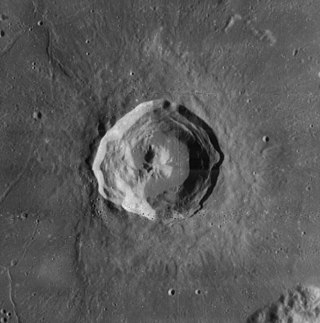
Bürg is a prominent lunar impact crater in the northeast part of the Moon. It lies within the lava-flooded, ruined crater formation designated Lacus Mortis. To the south and southeast is the crater pair Plana and Mason. To the west, beyond the rim of Lacus Mortis, is the prominent crater Eudoxus.

Bilharz is a lunar impact crater that lies in the eastern part of the Mare Fecunditatis. It is the largest member of a close triple-crater formation with Atwood to the east and Naonobu to the northeast. To the southeast is the crater Langrenus.
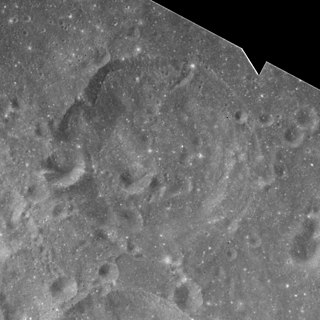
Naonobu is a small lunar impact crater named after Japanese mathematician Ajima Naonobu. It is located on the eastern Mare Fecunditatis, to the northwest of the prominent crater Langrenus, and it forms a triple-crater formation with the adjacent Atwood to the south and Bilharz just to the southwest. Naonobu and Atwood are separated by only a few kilometres.
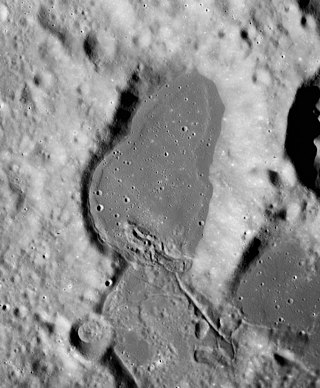
Bowditch is a lunar impact crater that lies on the far side of the Moon, just beyond the eastern limb. It is located on a region of the lunar surface that is brought into view due to libration, but at such times the area is viewed from the edge and so not much detail can be observed. It lies just to the north of the small Lacus Solitudinis lunar mare, between the craters Titius to the southwest and Perel'man to the east-northeast.

Watts is a small lunar impact crater that is located at the extreme northern edge of the Mare Fecunditatis. It was named after American astronomer Chester Burleigh Watts. Just one crater diameter to the northwest is the irregular da Vinci. Farther to the south is the larger crater Taruntius.

Lawrence is a lunar impact crater that is located on a section of terrain to the east of Mare Tranquillitatis and northwest of Mare Fecunditatis. It was named after American physicist and Nobel laureate Ernest Lawrence and American astronaut Robert Henry Lawrence, Jr. To the southeast is the larger crater Taruntius. The rille designated Rima Cauchy crosses the eastern part of the Mare Tranquillitatis and reaches as far as the northern rim of Lawrence.
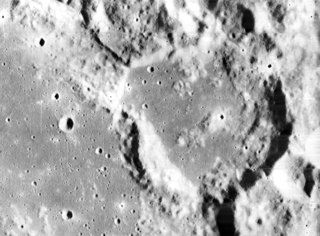
Condon is a lunar impact crater that lies on the eastern shore of the Sinus Successus, a bay along the northeast edge of Mare Fecunditatis. It was named after American physicist Edward U. Condon in 1976. It lies midway between the larger crater Apollonius to the north and the smaller Webb to the south on the Mare Fecunditatis. Condon was previously designated Webb R.

Crozier is a lunar impact crater that is located on the southwest edge of Mare Fecunditatis, a lunar mare in the eastern part of the Moon's near side. It lies to the east-northeast of the prominent crater Colombo, and southeast of the small crater Bellot.

Ibn Battuta is a small lunar impact crater on the Mare Fecunditatis, a lunar mare in the eastern part of the Moon's near side. It lies to the southwest of the crater Lindbergh, and northeast of the prominent Goclenius.

Pasteur is a large lunar impact crater, approximately 233 kilometers in diameter, belonging to the category termed a walled plain. It was named after French chemist and microbiologist Louis Pasteur. It lies on the far side of the Moon as seen from the Earth, just beyond the eastern limb. The vicinity of this crater is occasionally brought into view from Earth due to librations, although not much detail can be seen.







